An edible Parasol look-a-like that can cause gastric upsets in some people.
Home / Mushroom Guide /
Shaggy Parasol
Shaggy Parasol
| Mushroom Type | |
| Common Names |
Shaggy Parasol (EN), Parasol Cennog (CY), Czubajka Czerwieniejąca (PL), Piruló Őzlábgomba (HU) |
| Scientific Name |
Chlorophyllum rhacodes |
| Synonyms |
Macrolepiota rhacodes, Lepiota procera var. rhacodes |
| Season Start |
Jul |
| Season End |
Nov |
| Average Mushroom height (CM) |
10-20 |
| Average Cap width (CM) |
10-20 |
Please note that each and every mushroom you come across may vary in appearance to these photos.
Cap
10-20 cm. Starting ovate, smooth and pale brown/pink opening to flat with shaggy brown scales on a white background, usually with a smooth umbo.
Gills
Gills crowded and free of the stem. White when young turning pale tan/pink bruising red/orange.
Stem
10-20 cm long, 1-1.5 cm diameter. White to pale pink/brown. Smooth and plain with a double edged ring. Bulbous at the bottom.
Skirt
Has a double edged skirt that can become unattached and moved up and down the stem. Darker on the underside.
Bulbous Base
Has a bulbous base that is not as large and is not marginate like the Brown Parasol.
Habitat
Mixed woodland and anywhere shady particularly with conifers. Grows in troops or rings but can be found individually.
Possible Confusion
When young this mushroom looks similar to some of the deadly Amanitas, due to the fact it has a bulbous base, but there is no sac-like structure (volva), and can have a similar looking cap. The confusion with dapperlings (Lepiota spp.) which are smaller can be ignored if the mushroom cap is over twelve centimetres in diameter, when mature nothing that looks similar is anywhere near as big apart from the Parasol mushroom (Macrolepiota procera), pictured and the Brown Parasol (Chlorophyllum brunneum).
The Parasol has a snakeskin like dark brown pattern on the stem, the Shaggy Parasol has a smooth off white stem.
The brown Parasol has a large, bulbous, marginate base, the Shaggy Parasol has a bulbous base but is not as large and is not marginate.
Spore Print
White. Ellipsoid, dextrinoid. You should scrape your spores into a small pile to get an accurate spore colour.
Taste / Smell
Good but must be cooked. Can cause gastric upsets in some people.
Frequency
Common.
Other Facts
Shaggy Parasols can cause gastric upsets in some people, if you are trying some for the first time, cook well and only try a small amount, wait 24 hours to see if there is a reaction.
The epithet (2nd part of the scientific name) as ‘rachodes’ was a misspelling of the Greek rhakos or rhacos which means ‘piece of cloth’.



 (90 votes, average: 3.51 out of 5)
(90 votes, average: 3.51 out of 5)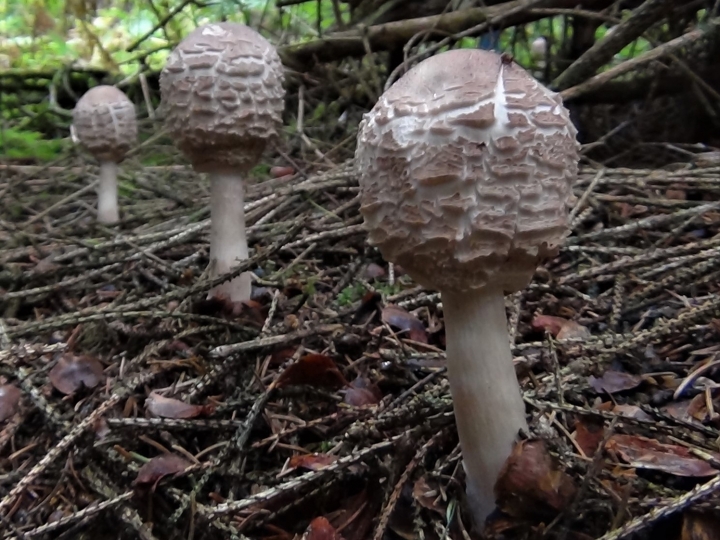















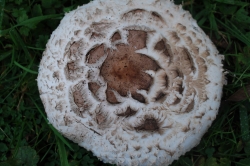
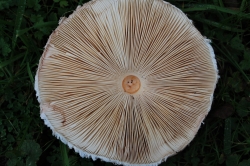
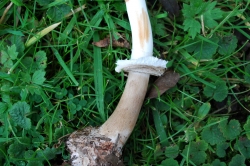
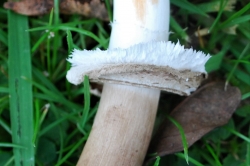
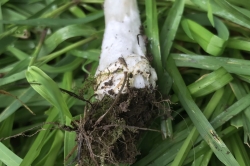
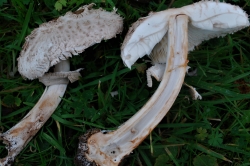
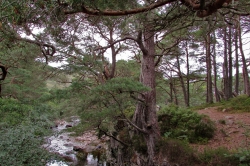
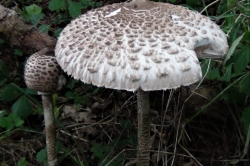







Leave a Reply